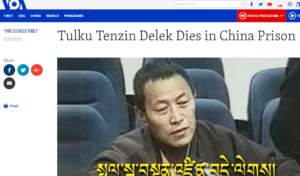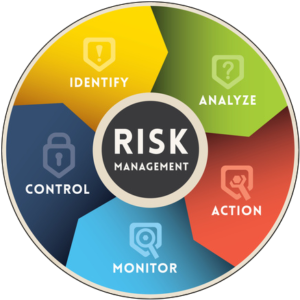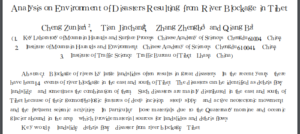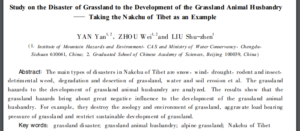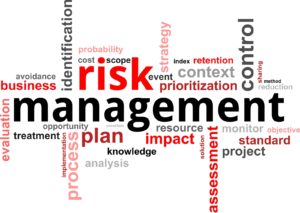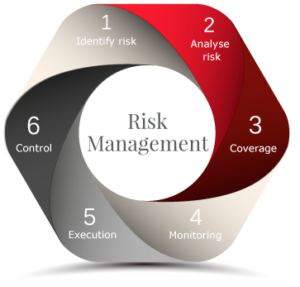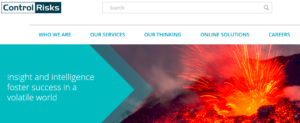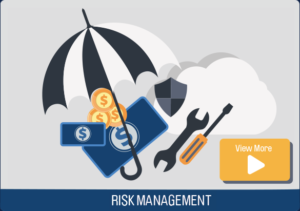BLOG ONE OF TWO ON RISK MANAGEMENT: Chinese style, Tibetan style
When a corporation decides to float its shares on a stock exchange, potential investors have one simple question in mind: will I make money?
Answering that question these days brings in an entire industry of risk analysts, financial advisers and their impressive graphs rating and extrapolating risks based on past events. The massive enumeration of all conceivable risks starts with the corporation floating its shares in an IPO (initial public offering) declaring its own risk analysis. Any reputable stock exchange makes this disclosure of risks mandatory, requiring the IPO applicant to file a voluminous compendium of all conceivable, imaginable risks, thus shielding the corporation from later lawsuits alleging investors weren’t warned. So the stock exchange enhances its reputation as something more reputable than a casino, and the newly listed company protects itself against being sued. You were warned.
As a result, the risk disclosure list gets longer and longer, with each corporate filing. Take, for example, the recent risk disclosure of Tianqi Lithium, seeking a share price trading on the Hong Kong Stock Exchange. Tianqi basically has just three assets. Two are deposits of rock lithium (spodumene) in two very different locations, in anticipation, much shared by investors and their advises, of a boom in lithium prices as global demand soars to keep pace with soaring production of lithium battery powered electric cars. Tianqi’s other major asset is in Chile, where it now owns salt lakes brimming with lithium, recently acquired from Chilean state-owned SQM.
Tianqi’s three assets are in Chile, Western Australia and Tibet. It’s not every day that a lithium deposit in Tibet floats on a stock exchange as a desirable investment, magnetising capital. It’s a first. Tibetans have more than one simple question to seek answers to.
Tianqi’s prospectus, available online from the Hong Kong Stock Exchange is a massive 690 pages, and the “Risk factors” section is 43 pages, yet nowhere does it identify the Tibetan location, deeply distressing to nearby Tibetan communities, as inherently risky.
This is remarkable, given the overwhelming thoroughness of listing all conceivable risks. So comprehensive is the risk analysis it becomes eye-glazing, with no way of telling the possible from the probable, the far-fetched from the plausible. Maybe that is the point: a blizzard of information is as effective as disclosing nothing, there’s just too much to take in.
The Tibetans of Kham Lhagang know all about spodumene lithium mining, as there are active lithium mines close by the Tianqi deposit, which is yet to be exploited. There have been protests, and much anguish in Tibetan communities about mining transgressing nearby sacred mountains, releasing toxic heavy metals into waste storage dams that must securely prevent dangerous tailings from entering water catchments for many decades to come, long after mining has ceased extraction. A beloved leader of these communities, Tulku Tenzin Delek was arrested, charged with inciting terrorism, convicted and died in a Chinese prison, for protesting these assaults on the environment. He is revered today more than ever, despite his official status in China as a criminal terrorist.
How could Tianqi have failed to notice it is not liked, by the population around its Tibetan asset? They do mention as risks climate change, rising sea levels, and the Tibetan climate: “We operate in areas that are under threat of ice storms, floods, earthquakes, landslides, mudslides, sandstorms or drought.”
Even more remarkably, Tianqi acknowledges that in Western Australia nearby Aboriginal communities, under Australian legislation, have lodged unresolved claims to Native Title over the lands that include the Tianqi Greenbushes lithium mine. Far from being risky, this is a well-established process in Australian law for acknowledging the rights of indigenous communities to recognition of prior possession, long before white men and geologists arrived only two centuries ago. If, after lengthy court proceedings, native title is granted, which seldom happens in settled areas where white migrants were granted freehold title to land, the end result is that the local Aboriginal community is awarded nominal rights to use their land for traditional purposes, and to lease it back to the state, if it’s a national park, or to the mine owners. At most, a successful Native Title claim would necessitate Tianqi to train and employ more local Aborigines, pay a little more in royalties, and develop a workable ongoing relationship with the Aboriginal community. One could even argue that this legal requirement that a corporation get involved in local welfare and governance might become a learning Tianqi could, to everyone’s benefit, apply to its Tibetan mine.
RISK IS A GLOBAL INDUSTRY
This is more than a footnote to a corporate IPO disclosure filing. Risk analysis is a major global industry; we live in a risk-obsessed world. The delusion that risks are in advance knowable and quantifiable powers a charade of foreknowing that in practice privileges quantifiable, nameable risks, while ignoring the unnamed, unforeseen risks that do the most damage.
Tianqi’s filing of its IPO prospectus in an HKEx application is one of the first times a Tibetan treasure has become a globally traded commodity attracting investors worldwide, although Warren Buffett was, as usual, far ahead of other investors, in buying a stake in a Tibetan lithium lake back in 2008, right in the midst of the unforeseen risk of a global capitalism meltdown eventuating.
If Tibetan lithium is now, as wealth management advisers say, a “play”, is the right response to append it to the endless list of risks inherent in any investment in the boom and bust cycles of mining especially, and capitalism more generally?
Tianqi’s Tibetan lithium play may indeed be risky, but there is a bigger point to be made. For starters, traditional Tibetan attitudes to risk shift us to a very different reality. The risks of everyday life on the vast pasture lands of the Tibetan Plateau go well beyond the ice storms and mudslides listed by Tianqi. Livestock producers on an enormous island in the sky, at least 4kms up into the troposphere, face the laws of physics full frontal. In Tibet, a snowfall can manifest almost out of nowhere, even in summer.
 The list of risks is so long, Chinese have long assumed as self-evident that no-one, including Tibetans, would live in Tibet, if they had a choice. By sedentarising and urbanising Tibetans, removing them from pastoral production, China is doing the pastoralists a favour, making them enter history and the calculus of modern risk management. Compulsorily urbanised Tibetans live in comfort, even if in reality concrete housing, built by contractors out to skimp on materials wherever possible, is both hotter in summer and much colder in winter than traditional nomadic yak hair woven tents.
The list of risks is so long, Chinese have long assumed as self-evident that no-one, including Tibetans, would live in Tibet, if they had a choice. By sedentarising and urbanising Tibetans, removing them from pastoral production, China is doing the pastoralists a favour, making them enter history and the calculus of modern risk management. Compulsorily urbanised Tibetans live in comfort, even if in reality concrete housing, built by contractors out to skimp on materials wherever possible, is both hotter in summer and much colder in winter than traditional nomadic yak hair woven tents.
HOW TIBETANS FACE RISK
Lowland Han Chinese routinely look on daily life out on the range in Tibet with horror. It is everything modern urban China has escaped, and not so long ago that rural toil has been forgotten.
So risky is Tibetan life, protecting sheep from wolves, rounding up cattle on horseback amid the burrows of rodents, broken bones are common, likewise frostbite and sunburn, sometimes both at once. If Tibetans lived in accordance with contemporary risk management assessments, they would die of fright or never leave home.
The Tibetan attitude instead is one of insouciant, understated, stoic acceptance of risk as inherent to everyday life. That attitude is fast vanishing, now that urban China offers much more seductive alternatives, including the prospect of getting rich quickly by digging the pastures in spring for yartsa gumbu, the caterpillar fungus (ophiocordyceps sinensis) in great demand in China as tonic and aphrodisiac. Why bother with sheep if your land is right for yartsa gathering?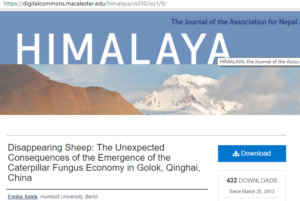
The hardiness of rural Tibetan life, of the people, the yaks, horses, goats and sheep, all hardy breeds, is worth considering, while it is still (just) with us, as an alternative, even an antidote, to the contemporary fixation on nailing down every conceivable risk, which only opens us to the inconceivable, such as a Great Recession generated by cleverly masking risks of subprime mortgages.
Ethnographer Robert Ekvall, in 1968 summed up a lifetime among the nomads of Tibet, depicting vividly the many risks drogpa nomads must take. Ekvall tells us: “The high-risk emergency life which they lead places premiums on aggressive personal decision making, quick and drastic responses to exigencies, and willingness to take calculated risks. There are no weather reports to forecast storms, or heavy snow, no market reports to show price trends in wool, no road reports to give trail conditions and tell whether passes are blocked or streams are in spate. Loss and gain are equally unpredictable. With acceptance of risk as the basic factor, the subsistence routine becomes a successive taking of chances, and when risk taking becomes a habit, the habit may well leave a mark on personality.
“There is a common greeting, in the form of a question, to which I have never heard an affirmative answer. E dKaa THal? Has there been difficulty? Is the question asked of the guest as he enters the tent, is shouted to riders coming within earshot from every form of venture, trade, hunting, raiding, pilgrimage, or long-range herding. The invariable answer is Ma dKaa THal, There has been no difficulty.”[1]
It could just be that the Tibetans have much to offer, that we have seldom noticed. Acceptance of risk is one such; calmly acknowledging contingency and uncertainty. Another is a penchant for solitude, going off alone into the wilderness, up into the mountains, to face one’s own mind without the distractions of society. In a world filled more than ever by endless distractions, that too is worth considering as an asset of a different sort to a tradable spodumene deposit.
Rather than adding Tibet to the endless list of the world’s risks, let’s try subtracting. Looking at the world through Tibetan eyes deflates the pretensions of risk management, the hubris of pretending the future is knowable, even an essential of prudential business management. Foreseeing risks and threats becomes a self-sustaining narrative, because, as Tibetan lamas often remind us, risks, contingencies, uncertainties, possible failures and collapses are endless.
HOW NEW ERA CHINA DOES RISK
This matters because there is nowhere more hooked on risk management than today’s new era China. Risk management is what the ruling Communist Party is all about, positioning itself as uniquely capable of foretelling and averting risks, because it is so scientific and far sighted, capable of steering 1.3 billion humans to fulfil the China Dream. Risk management gives the CCP’s party-state its purpose, a teleology destined to result not only in China’s greatness but the rejuvenation of China as it navigates its way through the middle income trap to ever growing economic growth, while also pivoting from a low cost manufacturing base to a high income services based consumer led economy.
The party-state’s legitimacy rests on risk management, on being able to discern the key contradictions of our time, act decisively to resolve them, and steer China through all dangers to make it great again. Put simply, the party-state invents risks, then claims the credit for solving them.
One could argue that China’s current detention and compulsory re-education of as many as one million Uighurs in their Xinjiang homeland, is risk management taken to extremes. The well-documented detention and forcible slogan chanting of CCP campaign mnemonics is a massive investment in remoulding human minds en masse, in the belief that this is essential risk management.
To the rest of the world, the scale of incarcerations and coerced compliance with party songs, party slogans, party formulations, is counter-productive, generative not of freshly washed minds but of bitterness and hatred. The few Uighurs and Kazakhs who escape, and can speak, say just that.
This is a classic negative feedback loop, a vicious spiral. The more official China is convinced Xinjiang is a risk, a nest of terrorists in the springboard of China’s Eurasian Belt & Road Initiative, the more punitive it gets; and the more punitive the treatment of Uighurs, the more inclined they are to turn to extremes.
Official China is delusional not only in driving millions of Xinjiang Uighur Muslims to extreme alienation, despair and anger, but in its tech-driven assumption that all risks can be controlled. All it takes is sufficient investment in the technologies of surveillance, and stationing police posts everywhere, demanding Uighurs routinely hand over their phones for scrutiny of content, widespread use of facial recognition tech to identify and re-educate the dissidents, even when they rapidly become a high proportion of the entire Uighur population.
China does not know how to get out of this whirlpool of risk management sucking it down, nor do the Uighurs. The rest of the world looks on, mostly indifferently. Decades of depicting the Uighurs as Islamic terrorists, or at least sympathetic to Islamic terror, has paid off, and the world looks away.
CHINA’S HIGH RISK AGENDA
China is also taking many risks it does not want to acknowledge as risky, or face. Since it is axiomatic that the CCP alone has mastery of the (Marxist) contradictions that define these new era times, by definition the CCP alone also has the answers, the master strategy for achieving, simultaneously, China’s continuing growth, the construction of “ecological civilisation”, successful outreach across Eurasia linking all Eurasian economies (and beyond) to China’s co-prosperity sphere, while also spending big on competing, in all war-fighting spaces, with a massive US investment in weaponising the US-China rivalry. China’s capacity to achieve all of this, while also investing hugely in an elaborate social credit system of punishments and rewards for each heavily surveilled Chinese citizen –Xinjiang is just the beginning- also depends on deeply entwined connections with China’s online giants and other corporates. That too is hugely risky, as China’s equivalents of Facebook, Google, Amazon etc. may at some point find, no matter how much they benefit from China’s firewall, they need to distance themselves from an increasingly centralised, authoritarian, punitive state. These are among the major risks China does not want to even think about.
The CCP loudly congratulates itself for its mastery of the “laws” of history, economics, power projection, sovereignty assertion, development and now pollution control and biodiversity protection. That’s a tall order, a high self-rating fraught with risk.
The party-state is hugely ambitious, in order to persist in its claim to be uniquely capable of steering China past all risks and dangers, into ever greater accumulations of wealth and world leadership and global; dominance of several emerging hi-tech industries, all at the same time. This is high wire, high stakes juggling, and risk management of an extraordinary intensity. Since there are so many barely acknowledged risks looming, whether they can be named and debated or not, an increasingly centralised and authoritarian China is all the more determined to crack down on well-known risks, such as Islamic discontent in Xinjiang.
RISK MANAGEMENT MEDICALISED AS CONTAGION CONTROL
When official China extends its gaze to Xinjiang, it deploys all the standard metaphors of risk management, and the imperative of control. Uighurs must learn Chinese, study the laws they are required to obey and acquire job skills in the casual wage economy rather than rely on traditional farming and livestock raising skills. They must cut off beards, uncover heads, present shaven and unconcealed faces to the endlessly repetitive video and human police surveillance, proving several times a day they are not a risk to the party-state. If for any reason they fail this intrusive scrutiny and are 00 judged a potential risk, they are detained indefinitely in “re-education centres” where, behind bars, they cease all acts of piety and devotion, and loudly sing songs of praise of the benevolent Chinese Communist Party. They attend compulsory lectures on the wisdom and historical inevitability of rule by the party-state, and must repeat official slogans over and over. This is behavioural therapy on a mass scale. They are required to overtly renounce their past way of life, and write essays of self-criticism showing they understand the error of their ways. They are corrected, and corrected again, until they master the key slogans of Xi’s new era and its aspirations.
Eventually, when detention without charge or trial ends, and people can go home, they remain under close surveillance and under pressure to inform on their intimates, to prove their loyalty to the party-state. Cameras may be placed inside the home, so there is nowhere space to be beyond the panoptic gaze of the state. Cadres may be sent to live with your family and conduct round the clock corrections of behaviour lacking in quality or sufficient overt loyalty to the sovereign state. Allocation of party activists to embed within family life is now common, and one cannot refuse.
Nominal regional ethnic autonomy notwithstanding, the Uighur language and culture are now treated as pathologies, to be eradicated, likened to a virus that could infect a whole society if not rigorously exterminated. “Local officials sometimes liken inmates to patients requiring isolation and emergency intervention. Anyone infected with an ideological ‘virus’ must be swiftly sent for the ‘residential care’ of transformation-through-education classes before illness arises,” a document issued by party authorities in Hotan said.”
China naturalises its self-defeating cleansing of the scourge of wrong loyalties by medicalising the dominant tropes, building a hegemonic discourse of pathology, plague, infection, pandemic, hence an objective need for sweeping and intrusive sanitation strategies to purify the body of society, lest contagion spread disastrously. Vectors of disease transmission are immediately identifiable by their beards and head scarves.
An official Chinese message to Uighurs: “Members of the public who have been chosen for re-education have been infected by an ideological illness. They have been infected with religious extremism and violent terrorist ideology, and therefore they must seek treatment from a hospital as an inpatient. … The religious extremist ideology is a type of poisonous medicine, which confuses the mind of the people. … If we do not eradicate religious extremism at its roots, the violent terrorist incidents will grow and spread all over like an incurable malignant tumour.”
Tibet and China have taken different paths to the current moment, embodied in their differing attitudes to risk. The wealthier China gets, the more anxious it gets. For China the risks grow and grow, requiring more aggressive, intrusive, strike hard methods.
How will this all turn out? Is it significant that repression in Tibet is not as heavy as in Xinjiang? Can we learn something from the ways Tibetans do risk? Those are the questions addressed in the second of these two blogs
[1] Robert Ekvall, Fields on the Hoof: Nexus of Tibetan Nomadic Pastoralism, Holt, Rinehart, 1968, 75, 83, 91-2

